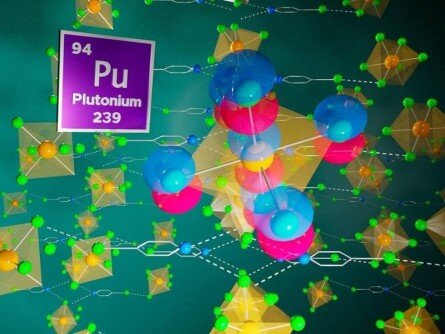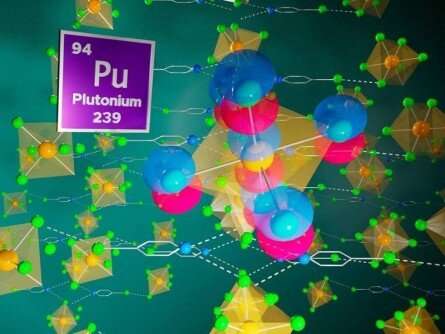

Understanding the arrangement of electrons in compounds containing actinide elements, such as uranium and plutonium, can help advance the design of next-generation nuclear materials. These elements are challenging to study due to their complex chemistry and radioactivity. Additionally, these elements, which are in a sequence of related elements called the actinide series, have electrons that are organized in ways that don’t match theoretical predictions.
Researchers have synthesized five different hybrid materials containing a particular compound subunit of plutonium and chlorine: the [PuCl6]2- anion. They probed the anion’s electronic structure and found that while the electrons in the plutonium-chlorine bonds were mostly not shared (ionic), they also featured important contributions from covalent bonds where the electrons are shared. These covalent bonds correlated with the 5f shell of the quantum-mechanical model of the atom. This shell is also the region of mismatch between scientists’ observations and theories of how electrons are organized around atomic nuclei.
The research is published in the journal Inorganic Chemistry.
Researchers synthesized five different hybrid materials, (4XPyH)2[PuCl6], where X= H, Cl, Br, I, and (4IPyH)4[PuCl6]·2Cl, from an acidic, chloride-rich aqueous media. The team included researchers from Pacific Northwest National Laboratory (PNNL), George Washington University, the University of São Paulo, and the State University of New York at Buffalo. The researchers then probed the electronic structure of the [PuCl6]2- anion by using the quantum theory of atoms in molecules and natural localized molecular orbital analysis. The researchers delineated the underlying bond mechanism and hybrid atomic orbital contributions within the plutonium-ligand bonds. The research team also evaluated two related compounds that they had reported in previous papers. The researchers subjected materials containing the [PuO2Cl4]2- and [PuCl3(H2O)5] molecular units, to the same level of analysis to establish trends in bonding.
The results revealed the Pu-Cl bonds were predominantly ionic, yet featured important covalent contributions that increased as bond polarity decreased from [PuCl3(H2O)5] 2Cl4]2- 6]2-. Similarly, the Pu-based hybrid atomic orbitals in the Pu-Cl bonds exhibited decreased s and d orbital character, while the f orbital contribution increased. However, the Cl-based hybrid atomic orbitals did not vary significantly. This indicates that the 5f shell contributes to the covalent character of the Pu-Cl bond. This level of analysis provided valuable insight into the role of oxidation state, coordination geometry, and metal-ion charge in plutonium-ligand bond analysis.
The results of this study help scientists understand and predict the chemical and physical behavior of transuranic elements—elements beyond uranium in the periodic table. This is an important step toward advancing the design of next-generation nuclear materials. It could also help more effectively manage nuclear waste. By gaining new information on the role of the 5f shell in plutonium-chlorine bonds, this research contributes to the collective goal of resolving the f-electron challenge. Resolving this is the overarching goal of the Department of Energy Office of Science’s Heavy Element Chemistry program.
More information:
Robert G. Surbella et al, Plutonium Hybrid Materials: A Platform to Explore Assembly and Metal–Ligand Bonding, Inorganic Chemistry (2022). DOI: 10.1021/acs.inorgchem.2c02084
Provided by
US Department of Energy
Citation:
Exploring bonds and electronic structure in plutonium hybrid materials (2023, March 27)
retrieved 27 March 2023
from https://phys.org/news/2023-03-exploring-bonds-electronic-plutonium-hybrid.html
This document is subject to copyright. Apart from any fair dealing for the purpose of private study or research, no
part may be reproduced without the written permission. The content is provided for information purposes only.